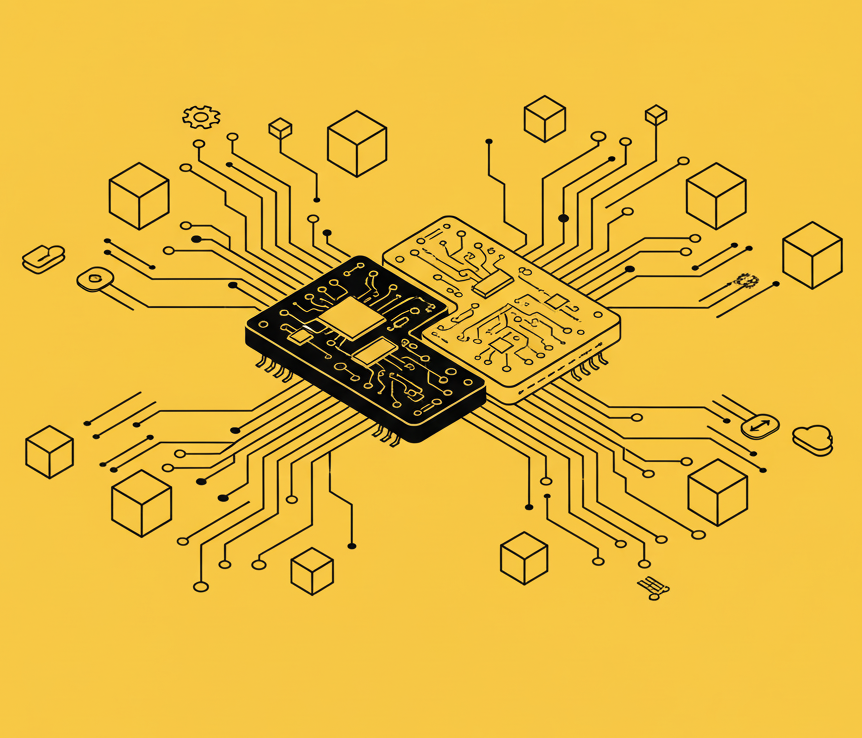A detailed guide to hybrid embedded architecture for product and engineering leaders
Connected products are moving beyond stand-alone firmware. The winning pattern is a hybrid embedded architecture: do time-critical work on the device, and push heavy compute, storage, analytics, and fleet ops to the cloud. This model pairs real-time responsiveness with elastic scale and simpler operations. Below is a concise playbook on why it matters, what to build, and how to roll it out with security and maintenance in mind.
What is a hybrid embedded architecture?
A product pattern where:
- Edge (device): Handles sensing, actuation, safety paths, and latency-sensitive UI even when offline.
- Cloud: Handles orchestration, long-term data, analytics, ML training/serving, device twins, and fleet ops.
- App/Portal: Presents state, insights, and controls to users and operators.
One sentence definition: Keep real-time decisions at the edge; centralize everything else for scale and learning.
Why Use embedded architecture?
The old “device-only” approach struggles in a world of constant connectivity and updates. Cloud-only isn’t right either—latency, outages, and single points of failure. Hybrid combines the strengths of both:
- Real-time where it counts: Keep control loops, sensing, and safety paths local so they work even when the internet doesn’t.
- Scale without overbuilding hardware: Use modest on-device resources and burst to cloud compute and storage when needed.
- Richer features over time: OTA firmware, remote diagnostics, analytics for predictive maintenance, and ML model iteration.
- Centralized fleet ops: Monitor, configure, and patch thousands of devices from one place.
Make the split early: device vs cloud
| Capability | Edge (device) | Cloud |
| Safety paths and control loops | ✅ | ❌ |
| First-run setup and local UI | ✅ | Assist |
| Schedules/policies | Cache & enforce | Source of truth |
| Credentials & keys | Secure element/TPM | Rotate, attest |
| Data storage | Short ring buffer | Long-term lake/warehouse |
| Analytics/ML | Light inference | Heavy training/serving |
| OTA execution | Receive/rollback | Stage/approve/track |
| Fleet ops | Execute commands | Orchestrate & audit |
Rule of thumb: If it breaks user safety or core function when the network drops, keep it on the device.
The CORE building blocks
Edge (on-device) intelligence, in motion:
- Offline behavior: Define what must keep working without a network (e.g., a lock still opens with valid credentials).
- Lean, resilient comms: Prefer MQTT/CoAP; queue and retry cleanly; watch timeouts and backoff.
- Strong device security: TLS for transport, authenticated endpoints, and hardware-backed key storage (TPM/secure element).
Cloud back end - Elastic services: Serverless, containers/Kubernetes, and managed databases to scale with load.
- Device state in the cloud: Use a device shadow/digital twin so apps can read or set state even when the device is offline.
- Data pipeline & analytics: Ingest telemetry reliably, then run real-time dashboards and big-data jobs for insights and model training.
Development process: from idea to scale
A. Design the split up front
Decide what lives on the device vs. the cloud using first principles. Example: a thermostat keeps control loops and local UI on the device; scheduling, weather-aware optimization, and remote access run in the cloud. Making this call early prevents expensive rework.
B. Develop in parallel with a shared contract
Run hardware, firmware, and cloud teams side by side against an executable spec and stable APIs. Use a HAL so core logic runs in simulation before hardware lands.
C. Integrate as confirmation—not discovery
With clear boundaries and CI/CD, integration should validate assumptions, not uncover them. Use automated test rigs to exercise the full path—sensor → device → cloud → device.
Security and upkeep over the product’s life
Security is ongoing: Regular audits, automated scans on firmware and cloud code, signed OTA updates, and an incident plan.
Operate the fleet: Cloud device management for health, metrics, remote fixes, and progressive rollouts. Feed crash/perf data back into the roadmap.
Outro: The integrated path forward
Hybrid architectures, align engineering with the business: faster features, safer operations, and a platform you can evolve. It’s a shift from shipping static devices to running a living product.
Ready to plan your next connected product? Get in touch with Better Devices. We’ll help you map the split, design the protocol, and stand up a secure, scalable system end to end.
FAQs
What’s the best protocol for fleets?
MQTT for pub/sub fleets; CoAP for constrained REST. Use both if the product spans patterns.
What belongs in a device twin?
Desired state, reported state, timestamps, and pending ops with reasons. Keep payloads small and versioned.
How do I handle clocks?
Use monotonic timers for safety paths. Sync wall time via NTP or GPS. Guard for skew and leap seconds.
Do I need a screen?
Often no. Use LED/tone/haptic patterns and surface detail in the app.
How do I prevent bricking during OTA?
A/B slots, signed images, health checks, and automatic rollback. Stage updates in waves.



